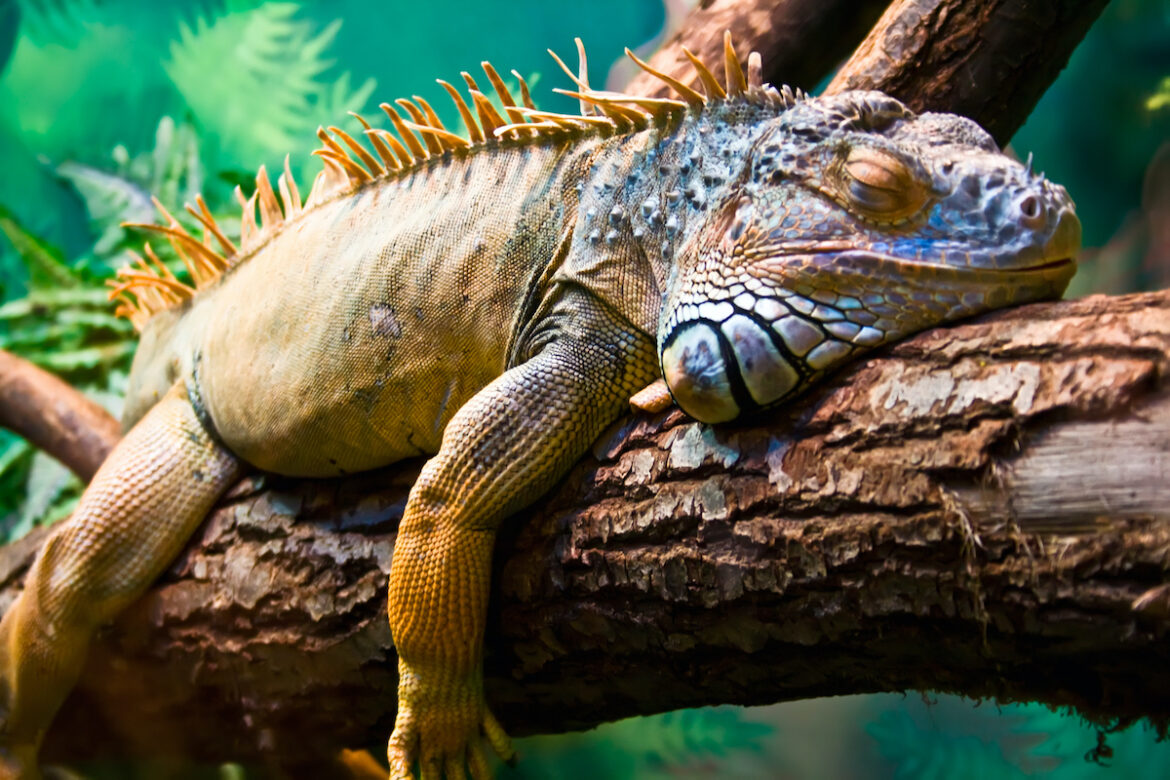To those who are unfamiliar with all the species that make up the reptile world, chameleons and iguanas can seem similar, but they are very different species who need to be appreciated for their unique characteristics and differences.
Chameleons and iguanas are both kept as pets, and both make great additions to the right family. If you are considering keeping either an iguana or a chameleon as a pet, you would need to know all about the differences between them to know which would be the best match for you.
What is the difference between a chameleon and an iguana? Chameleons are generally omnivorous and arboreal. They can change their color according to their mood. Iguanas are much larger with spines along their back. They are herbivorous and both arboreal and terrestrial. Neither are considered beginner reptiles and both require specialized care.
Each species makes the perfect pet for someone, but they have their individual characteristics and special requirements that make them more suited to one environment than another. It’s important to do your research to make sure the one you choose is the best fit for you and your family.
There are many differences between these two popular reptiles, so keep reading to find out more and to figure out which might be a better fit for your household!
All About Iguanas
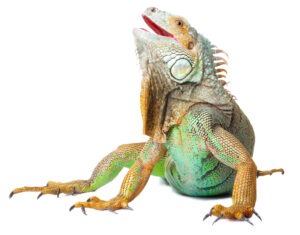
There are over 30 known species of iguana, with most coming from Mexico, Central America, and Brazil. Iguanas prefer hot climates, and to live somewhere close to water.
When kept as a pet, they need this environment to be replicated as closely as possible to lead a happy and healthy life.
If given proper care, attention, and regular handling, iguanas can become a valuable part of the family and fit in well with other animals and children.
It does help to keep in mind that iguanas can grow up to around 7 feet in length from their nose to the tip of their tail, so you will need to have adequate space for them to thrive in.
You will also need to groom and care for the. Socializing is also an important aspect to keeping any animal as a pet, but especially reptiles.
They’ll need to get used to you and their environment before you can safely handle them regularly.
Iguanas can live to be 20-years old, and this is definitely something to consider when making a long term commitment to keeping one! Never adopt any animal you’re not sure if you can keep for the full span of their life with adequate care.
Personality And Characteristics
Many people choose iguanas as their favorite reptilian pet, and they are actually among the most common domestic reptiles kept. Not only are they beautiful and impressive creatures to behold, but they’re also docile if socialized correctly.
The personality of an iguana changes as they grow. Young iguanas are quick and energetic and love to be quite active. However, as they grow, they become more docile and prefer to lay around and take in their warm surroundings.
Iguanas have thick claws and quite a dangerous tail, but they are mostly docile and will not lash at out their owners if they have been socialized properly. Just beware that they might enjoy climbing when out of their cage, as they spend quite a lot of time in trees in the wild, so be prepared to try to take them down from tricky places if you let them roam free!
Health And Care Of An Iguana

Iguanas do grow to quite a considerable size, up to 7 feet long, including their tail. They can also weigh up to 35 pounds. For a reptile, this is quite sizable!
This means that to properly care for your iguana, you would need to give them enough space in their cage or their own room.
Their cage or room needs to be heated to between 75-95°F and the humidity should be 70%. They also need ledges to climb and perch on.
Iguanas are strict herbivores and can become quite sick if they eat any animal protein.
The best diet for them would be a combination of pellets and leafy greens, as well as some fruit and supplements. This food needs to be in bite-size chunks, to avoid choking.
Training An Iguana
Do not expect to be able to train your iguana. They will not respond to commands as a dog might, and they have quite a mind of their own.
However, your iguana can become comfortable being handled by humans. To encourage this, you should regularly and carefully handle your iguana. This is the best way to get them used to being handled by you, but remember not to overdo it.
Do not force handling with your iguana if they are resisting it. Take it slow and watch for their cues to know when to put them down or when to pick them up. Some treats can definitely be used to help the process as well!
As A Pet
Iguanas make a great pet for a family, as long as they are given enough room and space to feel free and explore.
You do need to be aware that you will have to spend quite a bit of time bonding with your iguana and building that relationship. It is worth the whole family taking the time to bond with the iguana, so it can cement itself in the family dynamic!
Iguanas make for a good pet in a household that does not want to feed live food to their animals, as you would only need to feed them pellets, greens, fruit, and supplements. If you follow a meat-free diet or are squeamish when it comes to live feeding, an iguana is a great option.
You cannot keep an iguana locked in its cage and out of the way. They do take time and attention, and with some care they will become a part of your family. They live for up to 20 years, so they can become a long-term companion too.
Iguana Facts
- Average height – 50-75″
- Average weight – 10-35 lbs
- Lifespan – 15-25 yrs.
- Grooming – Bathing, shedding, and claw trimming
- Sociability – Sociable with family and other pets if properly socialized
- Exercise – Needs around 1-4 hours of exercise a day
What Else To Consider Before Adopting An Iguana
Take a look at this video from Clint’s Reptiles on YouTube explaining all the pros and cons on owning an iguana and how they compare to other domesticated reptiles.
All About Chameleons
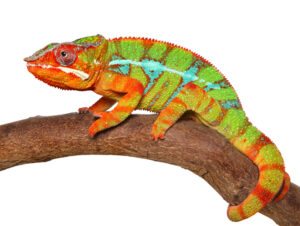
A chameleon is a much smaller pet to keep than an iguana, and they will spend more time in their cage as well.
A chameleon does not need to spend that much time out of its cage but instead loves to be left in its own environment.
Chameleons are generally shy creatures and do not enjoy being held. They can become stressed very easily and becoming stressed can even be quite life-threatening for them.
It is considered among many pet owners that chameleons should not be a pet for first-time reptile owners, as they are difficult to care for and it can be difficult to provide them with the right environment for success.
They are delicate creatures, and even the slightest problem in their environment could spell disaster.
Chameleons primarily live in rainforest trees, and trying to recreate this for them can be quite tough.
However, if you can achieve the perfect setup, a chameleon kept in captivity and cared for properly can live for 3-10 years. This will also depend on the type of chameleon as well.
Personality And Characteristics
Chameleons are very shy creatures, and they are not the right pets to keep if you are wanting a pet to interact with and bond with. They are not pets to be taken out and handled, and they do not enjoy this at all.
They are beautiful and quite fascinating, but are pets that should be enjoyed from afar. If you put too much pressure on your chameleon or try to handle them too often, they can become really stressful. Stress for a chameleon can mean illness or even death.
Health And Care Of A Chameleon
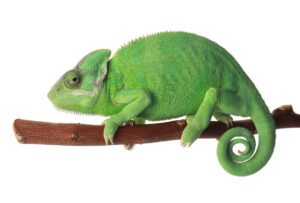
Chameleons are not as easy to care for as iguanas, which are already not the easiest reptile to keep happy. They primarily live in trees in the wild and spend most of their lives alone.
To keep a chameleon at home, you will need to provide them quite a large amount of vertical cage space, which can be quite an ask for such a small creature!
You will need to provide quite a lot of secure foliage and branches in the cage for your chameleon to climb around on as well.
You also need to ensure that you choose the right foliage for your chameleon, and you do not choose plants that might be toxic or foreign to them.
On top of all of this, you will also have to provide basking areas for your chameleon as well. They will need to be kept at 75-85°F. The optimal humidity for a chameleon is 50-85%, which means you will need a mister and UVA/UVB lights in the tank as well.
Most chameleons will also not take water from a dish and prefer to drink from droplets on leaves. This can be done through a dedicated dripping system, or through ice cubes used to drip onto leaves.
While iguanas are already high maintenance when it comes to space, regular handling, and humidity/temperature requirements, chameleons care is even tougher to get right.
Chameleons do need live food, such as crickets or waxworms. It is important to dust these with a calcium supplement twice a week for added nutrients. They also enjoy greens too.
Training A Chameleon
There is no chance that you could train a chameleon. They will not want to be handled and will not feel comfortable being put through any training. They might become familiar with feeding times and other routines, but this is as much as you could expect.
The best way to care for your chameleon is to leave them alone in a safe environment that is made to be as similar to their natural climate as possible.
As A Pet
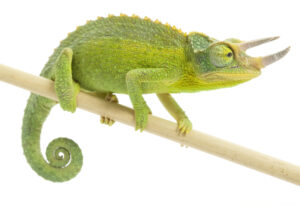
A chameleon is not the right pet to keep if you are wanting something to handle and bond with. They are cage-based pets and while they are fascinating, they should only be enjoyed from afar.
There is a lot of work that goes into caring for a chameleon. Their cage has to be at the right temperature and humidity levels, and you need to provide the correct foliage and drinking systems for them.
They are not a good option for young children or inexperienced reptile owners.
The investment in the right enclosure for them is substantial as well, so only consider a chameleon if you are prepared for the expense, time, and effort it takes to care for them.
However, if you have the knowledge and dedication to make your chameleon the perfect home, then chameleons make fascinating and beautiful pets.
Chameleon Facts:
- Average height – 12-20″
- Average weight – 1-6 lbs
- Lifespan – 3-10 yrs
- Grooming – Shedding
- Sociability – Not sociable
- Exercise – Not much
What To Consider Before Adopting A Chameleon
If you still can’t decide whether you’re up to the task of caring for a chameleon and are looking for a bit more information, the video below from Clint’s Reptiles will shed a bit more light on the topic of panther chameleons.
If panther chameleons aren’t your thing, here’s a video from the same channel all about the Jackson’s chameleon.
Which Is The Right Reptile For You?
Looking to bring home a new pet is always a big deal, and the more information you have, the better the choice you make. At first, to those who do not know much about either, iguanas and chameleons seem to be similar, and it is easy to assume that caring for them would be similar as well.
This is far from the truth. They are very different creatures and have very different requirements as well. Being the owner of either is also a very different experience.
Iguanas are very easy-going pets. They are sociable creatures and can fit into a family very well. They enjoy being handled if socialized from early on, and they do like human attention. Chameleons, however, do not like being handled and need to be left alone in their cage. If handled, they can become very stressed.
You will need to provide both an iguana and a chameleon with quite a lot of space as well, even though a chameleon is so much smaller than a fully grown iguana, which can reach 7 feet in length.
A chameleon needs lots of foliage and levels in its cage to explore and to feel at home high in the trees. Iguanas also need some perching spots but need more space, as they are considerably large in size.
Both chameleons and iguanas make for great pets, but for different reasons. An iguana can become a very important part of your family, bonding with you and other family members and enjoying human contact. Chameleons, however, are best for observing and appreciating their beauty from afar.
It is important to remember that both reptiles take a lot of work and care and are a huge commitment.
Iguanas And Chameleons In The Wild
Green iguanas, which are the most common in the wild, live in the treetops and open spaces in the Americas. They live near water and even go for regular swims. Despite their large size, they are fast and agile and are capable of fighting against predators.
Their tails act as a whip and their teeth are sharp enough to give up a good fight. In the wild, an iguana can lose their tail and just regrow a new one.
Chameleons are very different creatures. They are arboreal and live up high in trees. Chameleons prefer warm climates and do well in warm environments such as a rainforest or a desert. They can be found all around the world, in places such as Africa, Europe, Madagascar, and Southern Asia.
The most well-known characteristic of chameleons is that they can change their color, and this color is most commonly changed to suit their mood, not necessarily their background.
Iguanas Vs Chameleons
The two reptiles are very different, and anyone who is looking to bring one of these two reptiles home should understand the difference in behavior and care between the two.
If you are looking for a companion with whom you can interact with, then an iguana is a good option. If you don’t mind something more care-intensive and cage-dwelling, a chameleon would suit you better.
Related Questions
Are Chameleons Related To Iguanas?
Chameleons are part of the iguana suborder, but the two reptiles are very different otherwise and have very different needs.
Do Iguanas Make Good Pets?
Iguanas do make good pets, and they can be very rewarding pets to keep. However, it is important to remember that they do need proper care and attention, and they need to be socialized from early on.
Do Iguanas Like To Be Touched?
Iguanas do not necessarily like to be touched, but with time and socializing, you can train them to be tolerant of touching.
Up Next: Chameleons Vs Bearded Dragons As Pets – How To Choose
